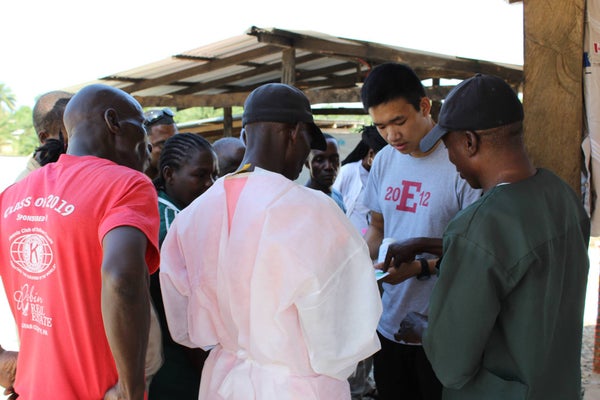This article was published in Scientific American’s former blog network and reflects the views of the author, not necessarily those of Scientific American
Jason Kang is a senior at Columbia University who studies biomedical engineering—but he’s also the VP of a biomedical device company, Jibon Health Technologies, and also the co-founder of another company, called Kinnos, whose products are protecting the lives of healthcare workers, first responders, and doctors around the world. It’s no wonder Kang, along with his best friends, fellow Columbians and Kinnos co-founders Katherine Jin, and Kevin Tyan were featured on the Forbes’ 30 Under 30 Healthcare list for 2016.
In 2014, Kang, Jin, and Tyan decided to enter Columbia’s Ebola Design Challenge, which solicited low-cost solutions to the Ebola crisis. Their idea was to create a powdered additive that could be mixed with the disinfectants used to sterilize workers’ uniforms. The powder, which they named Highlight, colorizes disinfectants to make it obvious if any spots on the uniforms have been missed during cleanup. Highlight also contains additives that allow disinfectants to spread more evenly on surfaces where liquids tend to bead up. Their success—they were finalists in the challenge—led them to found Kinnos, to market their invention.
When we learned about Kinnos, we decided to speak with Kang about his passion for improving human lives through biology and technology. We had a blast learning more about him, his friends and their company
On supporting science journalism
If you're enjoying this article, consider supporting our award-winning journalism by subscribing. By purchasing a subscription you are helping to ensure the future of impactful stories about the discoveries and ideas shaping our world today.
Check out our conversation with Jason below, which has been edited for clarity
TERRI BURNS: Tell me about your background, what you’re studying in school, and some of your interests.
I’m a senior at Columbia University studying biomedical engineering. I’m really interested in improving the status of health care around the world. What that means is introducing biomedical technologies to low-resource settings and addressing gaps in health care. With Kinnos, our goal is to improve disinfection to protect healthcare workers and the general public. When Columbia announced the Ebola Design Challenge in 2014, there was an opportunity to solve a really pressing need—a lot of health care workers were being infected by Ebola, and that’s due to an ineffective decontamination process.
So with two of my best friends, Kevin Tyan and Katherine Jin, we started working on Highlight. The problem is that disinfectants like bleach are transparent, and so you can’t really see them. It also forms droplets on waterproof surfaces, leaving gaps in coverage. The last problem is that it can evaporate in two or three minutes, but sometimes you need a longer contact time. With Highlight, we directly address all these problems. It’s a very simple, intuitive tool for people to visualize complete coverage.
How do you and your friends split up the work?
Well, we’re all actually fairly technical. I’m biomedical engineering, Kevin is biology, Katherine is biology and computer science, so we all have a very research-heavy background. That’s really helpful in terms of understanding pathology, working on experiments, writing our grants and so on... the distribution of work is very even. When it came down to more of the business side of things, training people, going out there, you kind of just learn on the spot.
How do you go about implementing this product? What’s the first step? How do you get materials and test it accurately?
I think that a lot of people have great ideas but don’t really know how to act on them. What it comes down to is building and testing. When we first started, we bought some materials… and just started playing around. To that end, a lot of the design of our product actually evolved over time.
At one point, we went to Mount Sinai Hospital and Staten Island Hospital…and they actually ended up buying our product. That was, I think, the start when we realized that this wasn’t just a project, but an actual venture. People wanted [Highlight] enough that they actually wanted to buy it. There’s actually a real need there.
You also just need to ask around. When you’re a student, you can just cold-email someone and say, “Hey, I’m a student, I’m working on something, can you please help me?” Playing the student card is really important. Another thing that is important is being very upfront about what you’re doing. By saying what you’re working on, that opens the door in the future that they might be a potential customer as well.
What is the most challenging part about what you do, and what is the most exciting?
Five years ago, when I was still in high school at Exeter, I never thought that I would be the type of person to start my own company….You’re living it 24/7 and there’s never a break. I think in that respect it’s very challenging. But it’s also the most rewarding because when it does work out, it makes it worth it in the long run. I think the reason why my friends and I are working on this, is because we, at a very fundamental level, care about helping others.
